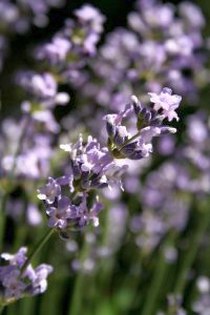Lavender Characteristics
(Lavendula vera, D. C.; L. Angustifolia, Moench.; L. spica, Linn.)

Name Origin:
From the Latin word Lavo, to wash, after a distillation of the flowers historically used in perfuming water for washing the body. We have two articles on the history of lavender – History of Lavender and Folklore and Medicinal Uses of Lavender.
Natural Order:
Labiatæ
Growing Cycle:
Half-hardy perennial undershrub.
Origins:
Native of the dry, calcareous uplands in southern Europe.
Height:
Lavender grows in a compact clump that reaches 24-30 inches tall.
Characteristics:
Tall, numerous, erect stems with small grayish leaves.
Lavender Flowers:
Small, violet-blue flowers on a terminal spike.
How to Grow Lavender
(Sowing seeds, cultivating, propagating and harvest)
Lavender grows best in light, limy or chalky soil. Lavender enjoys a sunny location and poor soil will lead to a stronger fragrance. Growing lavender in rich soil will make for larger plants but they will not be as aromatic.
Growing Lavender From Seeds
Sow lavender seeds indoors in March. Pinch out seedlings to retain 2 inches of spacing between lavender plants. When the ground is warm, plant 15-20 inches apart. The tall flower spikes are susceptible to breakage in windy conditions; plants may need to be planted in a protected part of the garden. Seeds remain viable for around 5 years.
Before planting lavender in your garden, you might find it helpful to consult our lavender companion planting guide.
Lavender Propagation
Cuttings are the primary way of propagating lavender. Young wood may be cut in August or April and placed directly into the soil. Do not allow to flower the first year to provide all of the plant’s strength into growing a strong root system. Lavender generally produces quality pickings and many commercial growers replace their plants every five years.
Lavender Cultivation
When the ground is warm, plant seedlings 15-20 inches apart. When growing lavender in colder climates, it must be protected or housed in a greenhouse or cold frame that can be covered during severe weather. Lavender pruning should be done in March
Harvesting Lavender
Cut the entire flower stem. This makes it easier to dry the flowers as well as encourages new growth. If cutting for oil production, wait until all of the blooms are fully developed to ensure the maximum amount of esters(scent) are present and harvest as early in the day as possible.
Lavender Uses
Lavender is sometimes grown for a condiment and used as an addition to salads and dressings, but its primary use is in perfumery. Lavender cookies are a special treat and we just happen to have a great lavender cookie recipe.
There was a time that a young girl was only considered prepared for marriage when, with her own hands, she had made her own linen and stored it with lavender.
Lavender Oil
Flower stems should be cut in August and covered immediately to protect them from the sun. Four-year-old plants produce more of the thin, pale yellow and fragrant lavender oil but two-year-old plants yield a better product. Lavender oil is one of the most prized of the essential oils. About 150-200 pounds of cut plants are required to obtain one pound of lavender oil.
Advice on Growing Lavender From an Expert
Did you know there is an entire book just about growing lavender? Sarah Bader is an American Lavender farmer.
plant. That is the case with Sarah Bader. Her book, The Lavender Lover’s Handbook: The 100 Most Beautiful and Fragrant Varieties for Growing, Crafting, and Cooking, is among the best sellers on Amazon on the subject of herb gardening.
It contains information on growing 100 different lavender varieties – it is virtually an encyclopedia on growing lavender and using the heavenly scented herb in recipes and crafts. If you love lavender and want it to thrive in your garden, you should check out her book.
